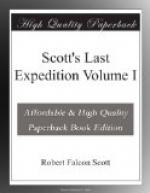Tuesday, December 12.—Camp 34. We have had a hard day, and during the forenoon it was my team which made the heaviest weather of the work. We got bogged again and again, and, do what we would, the sledge dragged like lead. The others were working hard but nothing to be compared to us. At 2.30 I halted for lunch, pretty well cooked, and there was disclosed the secret of our trouble in a thin film with some hard knots of ice on the runners. Evans’ team had been sent off in advance, and we didn’t—couldn’t!—catch them, but they saw us camp and break camp and followed suit. I really dreaded starting after lunch, but after some trouble to break the sledge out, we went ahead without a hitch, and in a mile or two recovered our leading place with obvious ability to keep it. At 6 I saw the other teams were flagging and so camped at 7, meaning to turn out earlier to-morrow and start a better routine. We have done about 8 or perhaps 9 miles (stat.)—the sledge-meters are hopeless on such a surface.
It is evident that what I expected has occurred. The whole of the lower valley is filled with snow from the recent storm, and if we had not had ski we should be hopelessly bogged. On foot one sinks to the knees, and if pulling on a sledge to half-way between knee and thigh. It would, therefore, be absolutely impossible to advance on foot with our loads. Considering all things, we are getting better on ski. A crust is forming over the soft snow. In a week or so I have little doubt it will be strong enough to support sledges and men. At present it carries neither properly. The sledges get bogged every now and again, sinking to the crossbars. Needless to say, the hauling is terrible when this occurs.
We steered for the Commonwealth Range during the forenoon till we reached about the middle of the glacier. This showed that the unnamed glacier to the S.W. raised great pressure. Observing this, I altered course for the ‘Cloudmaker’ and later still farther to the west. We must be getting a much better view of the southern side of the main glacier than Shackleton got, and consequently have observed a number of peaks which he did not notice. We are about 5 or 5 1/2 days behind him as a result of the storm, but on this surface our sledges could not be more heavily laden than they are, in fact we have not nearly enough runner surface as it is. Moreover, the sledges are packed too high and therefore capsize too easily. I do not think the glacier can be so broad as S. shows it. Certainly the scenery is not nearly so impressive as that of the Ferrar, but there are interesting features showing up—a distinct banded structure on Mount Elizabeth, which we think may well be a recurrence of the Beacon Sandstone—more banding on the Commonwealth Range. During the three days we have been here the wind has blown down the glacier at night, or rather from the S.W., and it has been calm in the morning—a sort of nightly land-breeze. There is also a very remarkable difference in temperature between day and night. It was +33 deg. when we started, and without hard work we were literally soaked through with perspiration. It is now +23 deg.. Evans’ party kept up much better to-day; we had their shoes into our tent this morning, and P.O. Evans put them into shape again.




